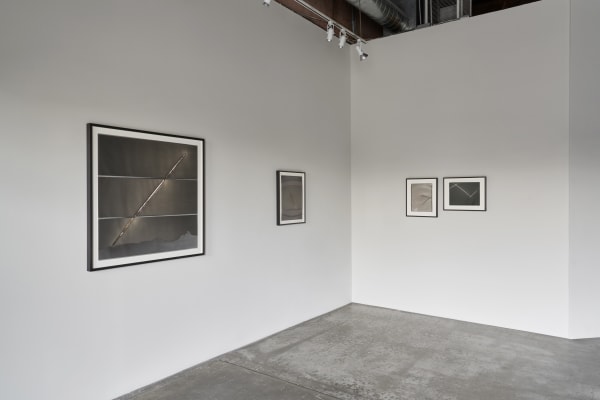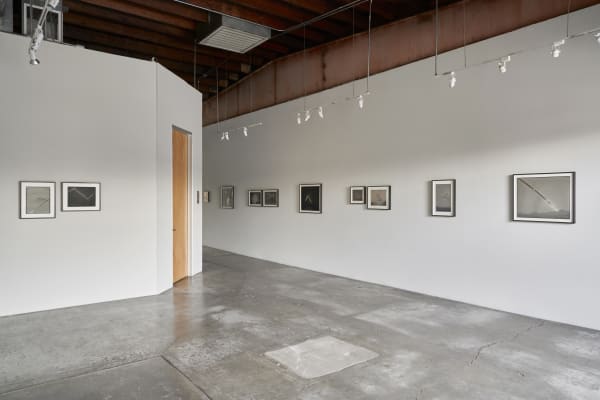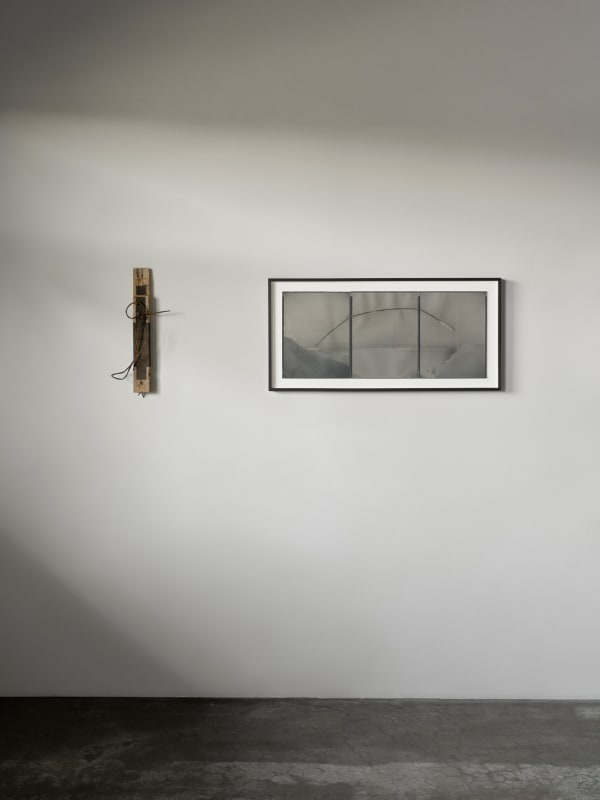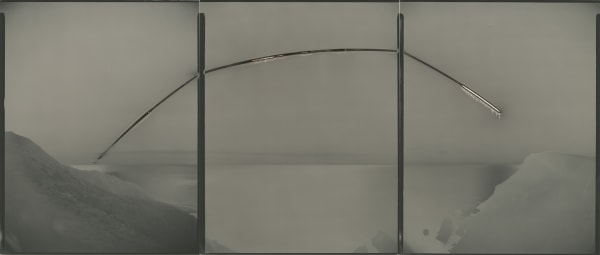TOUCH THE SUN: Chris McCaw, Roger Ackling, Alia Malley
Marshall Gallery is pleased to present TOUCH THE SUN, a three-artist exhibition exploring contemplative approaches to making photo-sculptural work in dialogue with the sun and the sky. In the main gallery, a decade-spanning installation of Chris McCaw’s unique, solar-scarred photographs is punctuated by the charred wooden sculptures of Roger Ackling, joined by Alia Malley’s altered aerial imagery in the project room.
Walkthrough with the artists:
Saturday, April 1st
12 pm
-
 Chris McCaw, Heliograph #59, 2015
Chris McCaw, Heliograph #59, 2015 -
 Chris McCaw, Sunburned GSP #885 (Mojave), 2015
Chris McCaw, Sunburned GSP #885 (Mojave), 2015 -
 Chris McCaw, Sunburned GSP #1065 (Mojave / Windy), 2022
Chris McCaw, Sunburned GSP #1065 (Mojave / Windy), 2022 -
 Chris McCaw, Sunburned GSP #1031 (Mojave / expanding), 2019
Chris McCaw, Sunburned GSP #1031 (Mojave / expanding), 2019 -
 Chris McCaw, Sunburned GSP #1070 (Pacific Ocean, Point Reyes), 2022
Chris McCaw, Sunburned GSP #1070 (Pacific Ocean, Point Reyes), 2022 -
 Chris McCaw, Sunburned GSP#1016 (Mexico), 2018
Chris McCaw, Sunburned GSP#1016 (Mexico), 2018 -
 Chris McCaw, Sunburned GSP #1059 (San Francisco Bay), 2020
Chris McCaw, Sunburned GSP #1059 (San Francisco Bay), 2020 -
 Roger Ackling, Voewood, 2010
Roger Ackling, Voewood, 2010 -
 Roger Ackling, Voewood, 2012
Roger Ackling, Voewood, 2012 -
 Roger Ackling, Voewood, 2010
Roger Ackling, Voewood, 2010 -
 Roger Ackling, Voewood, 2010
Roger Ackling, Voewood, 2010 -
 Alia Malley, ATIS_2034, 2019
Alia Malley, ATIS_2034, 2019 -
 Alia Malley, DTS_3017, 2022
Alia Malley, DTS_3017, 2022 -
 Alia Malley, DTS_3987, 2022
Alia Malley, DTS_3987, 2022 -
 Alia Malley, ATIS_1852 (The Ambassadors), 2021
Alia Malley, ATIS_1852 (The Ambassadors), 2021
The show’s title is inspired by a 2005 NASA book printed in braille and the phrase’s frequent use when their Parker Solar Probe entered the sun’s upper atmosphere for the first time in late 2021. For artists Chris McCaw and Roger Ackling, the idea that the sun’s light has traveled 93 million miles to touch the surface of their work is a source of profound and humbling insight. In the work of Alia Malley, the artist’s physical gestures imply similar astral phenomena akin to the stunning footage captured from the sun’s corona by the solar probe.
Over nearly two decades, California-based artist Chris McCaw (American, b. 1971) has perfected an inventive technique of exposing gelatin silver papers in camera, creating other-worldly, one-of-a-kind landscapes that uniquely trace and sometimes re-interpret the sun’s movement. In his iconic “Sunburn” and ‘Heliograph” pieces, prolonged exposures burn and scar the photographic paper as the sun is magnified by his custom-built camera apertures. A balancing act between science and art takes place as McCaw’s compositions must account for the season, weather, and the earth’s rotation to create his elegantly sliced vistas. The result is an ongoing body of work that anchors his process in the history of photography earning international exhibitions and notable placement in public and private collections.
In a quiet dialogue with McCaw’s photographs are the humble wooden sculptures of artist Roger Ackling (British, 1947-2014). After countless meditative hours, the works bear repeating, linear patterns burned in by the artist’s handheld magnified lens and sunlight. Creating work over nearly fifty years, Ackling garnered a reverent following of collectors who engage with the delicate energy embedded within his objects. He expressed that “what is made from this simple, concentrated ritual is held within the work itself. This presence can be re-absorbed through the senses and the eye.” Ackling’s process is photographic in its most fundamental expression; Mark-making using the properties of light, fulfilling the Greek etymology of the word itself (phos (light) + grâphe (drawing), and his works are held in collections and exhibited worldwide, including forthcoming major exhibitions in the U.K.
Beyond McCaw and Ackling’s shared celestial practice, a more delicate dedication to patience unites their creative approach to time and the physical elements of our terrestrial existence. Both meticulously plan a composition before stepping back to let their concentrated process take its effect over an extended period. Furthermore, McCaw and Ackling both primarily use found objects; Ackling wood scraps and driftwood collected or gifted from friends, and McCaw, a vast repository of expired, analog photo papers sourced through endless hours scouring the web.
The linear mark-making and cosmological interests on view in the main gallery are echoed by a special presentation of new works by Los Angeles artist Alia Malley (American, b. 1973) in the gallery’s project room. Contrasting the charred yet subtle gestures of McCaw and Ackling, Malley’s hand-altered photographs from “All That Is Solid” are more intense in creation, scale, and palette. Vividly colored, large-format aerials of mountainous deserts and monochromatic space-scapes are repetitively marked-upon, or away from, through the manual erasure of the print surface generating implied streaks of light that allude to astral phenomena and aerial catastrophes. Where McCaw and Ackling formalize controlled expressions of sunlight in direct contact with its radiating energy, Malley’s own vigorous, physical intervention illuminates each work, further activated by the artist’s scent-based elements that are present in the installation.




























